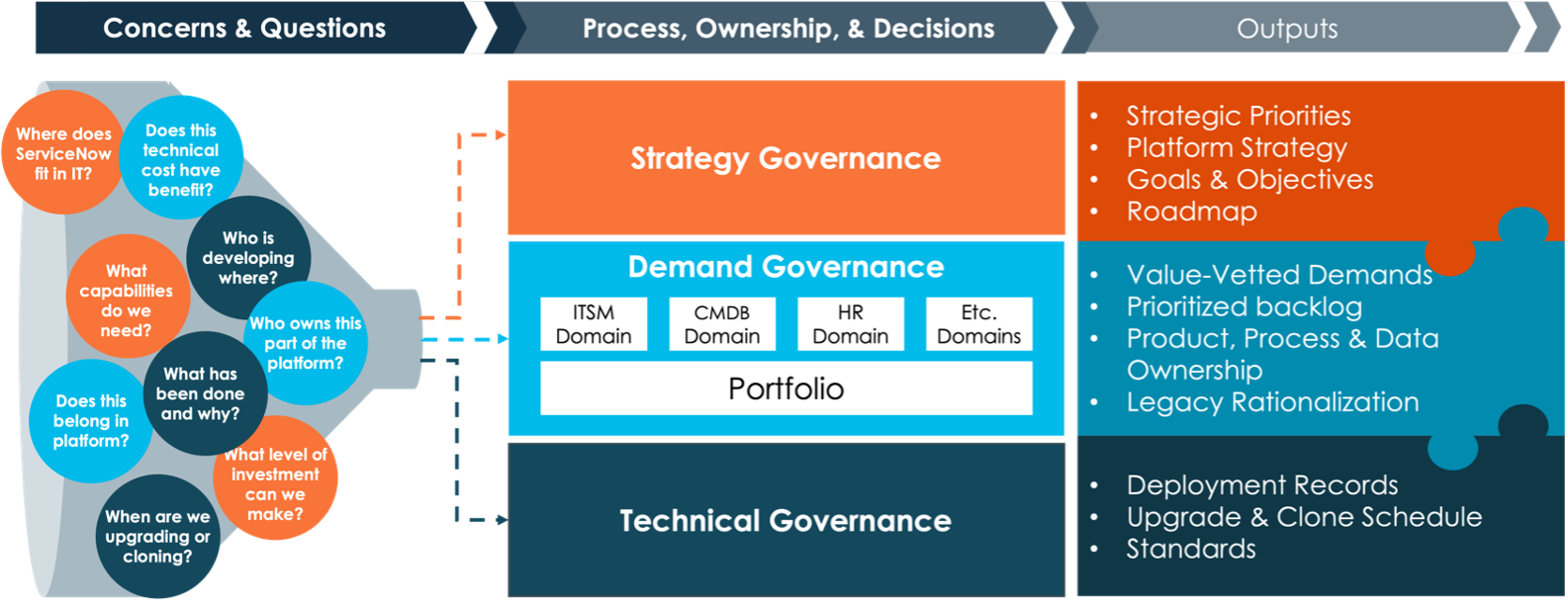
Why do we need Governance?
What’s the point of all this?
Welcome back to our hard-hitting series on Governance, our attempt to sift through the sand for the valuable nuggets you can use. If this is your first time here, you may want to take a look at part 1 of the series as we will be building off our definition of WHAT Governance is. You may be wondering how to get moving, or maybe even downloaded our Governance Package to get rolling on the process and started down the path. However, before we dive any further into some of those specifics – we need to address a critical point:

Why is Governance something we need? Well, there are quite a few layers to that question so let’s start to peel back the onion. Today we will:
-
Recap the point of ANY form of Governance
-
Understand why we need this for ServiceNow specifically
-
The bad stuff that happens when you DON’T govern ServiceNow with intent
-
The BENEFITS you can expect from a well-governed environment
Alright, let’s get into it, and continue your journey from the last article. If you haven’t read that one, that’s okay, though we will be continuing a story we started there so now MAY be a good time to catchup.
Order from Chaos
“That was a quite an Uber ride, never thought I would crack that nebulous word ‘Governance’ on my morning commute” you think to yourself as you move through the revolving door of your office building. Looking around now, it’s impossible for you to not see small systems under governance all around you. You stroll over to the Starbucks in your lobby and get into line. You begin to take note of all the little things you’ve never really noticed before and how they are making this all run so smoothly. You are in a roped off queue waiting your turn, the barista and everyone in front of you all know the drill, you can place an order from a clearly defined menu, and just simply tap your card to pay and then magically your coffee appears down the counter. You think about what a completely chaotic mess this would be if there weren’t all these little reminders and norms that everyone followed. Grabbing your cup from counter, you turn around and head to your floor.
In our last article, the final piece we talked about was how the Goal of ANY governance program should be to move as efficiently as possible without increasing risk in any sort of substantial way – i.e. to move fast under control. Listen, I FULLY understand that many of you may be rolling your eyes at the terms ‘Governance’ and ‘Efficient’ being used unironically in the same sentence BUT, that is actually what good governance looks to do: order inherently chaotic events into manageable systems to make them run faster. Let’s look at the Starbucks example from the passage. Think about just HOW chaotic this entire situation would be if there weren’t things like a standardized menu, a queue line, uniform payment methods, and so on. We all know there is inherent value in doing things in an orderly yet fast fashion, Governance in and of itself is necessary to bring order from the chaos of everyday situations. The thing is, you as a human being innately understand this and crave it. Anecdotal proof? Even when there isn’t a queue for something everyone is waiting for, people line up time and time again. We WANT the order. Well at least most of us…

Let’s get back to your morning:
Advertisement & Warning: Platform Can Do Anything
Sitting down at your desk you check your calendar. Platform team standup, 25 minutes. Ugh. As of late these have REALLY begun to wear on you. As the ServiceNow Platform Owner, you put these in 6 months ago to try to get everyone that is working on the platform talking, hoping that would solve the problems you have been having with the platform. Upgrades taking too long, breaks happening, no one aware of anyone else’s changes, the list goes on and on. With leadership breathing down your neck asking why ServiceNow is the 5th most expensive software spend at the organization, something had to be done. The meeting begins and an entire mishmash of people start talking about what they are working on. In house developers, a few partner leads, your admin; each take their turn announcing what they are working on. Project for HR, an enhancement to Incident, a custom app for Finance tracking IT assets, so on… Woah. It suddenly hits you just HOW much is being done for the organization on ServiceNow and in as many different ways. How is this even possible? You think about some of the cloud tools you’ve used in the past. Aside from some minor config and enabling SSO, most of the time you could get a POC running in a couple hours.
“Hmm, there is so much going on, maybe that’s why we keep talking about Governance…”
The meeting ends, and you head back to your desk, Governance firmly stuck in your mind.
If you are not overly familiar with ServiceNow, the first thing that may come to mind is “Wait, why do we need to move at pace under control for a technology? That doesn’t even make sense. Move? Shouldn’t it just do what it’s supposed to?” Reasonable question, and the answer requires a new definition, this time of ‘Platform’. Let’s ask Mr. GPT again:
An application platform is a foundational system that provides the tools, frameworks, and services needed to build, deploy, and run applications. Platforms also ensure compatibility and scalability, enabling applications to work across various devices or environments. Examples include cloud platforms…
If you are like me, you roll your eyes when every single technology gets referred to as a ‘Platform’. This definition above actually nails it – an Application Platform is something you can build applications on. As you may know, ServiceNow was created as an application development platform – it can do whatever you want it to. That a reason you buy it in the first place and pay the premium, because it can fulfill so many use cases on a single architecture. Being able to extract more and more value from it as you use more is what makes it so compelling.
This is the important thing – we need Governance specifically because ServiceNow is a platform. Multiple co-existing modules for different groups are deployed, integrations between them flow, and new development to solve new use cases is performed. So much going on, and this is a central constant of the value equation of ServiceNow, but it inherently makes it difficult to control and aim in the correct direction. In this sense, ServiceNow really operates as a microcosm of the broader technology environment – not simply providing a few finite capabilities for the organization, but rather an incredibly wide range of them, with the ability to build ALMOST any additional cases you want to via custom development. Unlike another tool used by a single group to do a single use case, which itself would fall under broader IT governance alone, ServiceNow is touching multiple stakeholder groups (and their budgets…) and can fulfill nearly limitless use cases. As a result, we need SOMETHING to allow us to tie to the broader business objectives and ensure that aligns with the strategy laid out for ServiceNow itself. Without direction and control on where we are going, we could have folks pulling in dozens of directions, not really moving us anywhere, but somehow costing more and more.

Let’s get back to your morning at the office.
Losing Control of a Fire
You open Outlook to see nearly half a dozen more meetings before lunch. The meetings drone on as usual and as you are almost ready to take a break, you think about how you are currently living through all the downsides of NOT having Governance in place at your organization. You just had a call with your boss who, once again, brought up the cost of the platform, seriously called it ‘ServiceNever’, as well as the fact nothing ever seemed to work properly on it. He even brought up the idea of just nuking it all and starting fresh or even just jettisoning the product entirely. You rub the bridge of your nose.
“We need to get things under control here.”
You have heard all the success stories and have even had people close to you tell you that it really is possible to move quickly and deliver value with the platform. In all those cases, it seemed like they had something you clearly don’t – control. You think a bit about where you head was earlier in the morning, and that term – Governance. Is that REALLY the answer to your problems here? It certainly appears as though us not having a handle on that at ALL right now clearly isn’t working.
Unfortunately, this is an all-too-common situation that we have seen customers in. Collectively as a team, we have handled dozens of customers who simply wanted to zBoot their instance and start fresh. Problem was – it wasn’t going to fix anything. The problem is rarely the technology itself, and yeah, a hard reset CAN be a useful tool in an overall program to fix the problem, but it is not a silver bullet. We’ve also fielded hundreds of calls where ServiceNow simply ‘didn’t work’. 99 times out of 100, these were changes the customer had themselves made, but the reason why had been lost to org changes or simply forgotten.
These are all symptoms of not governing your platform correctly and simply piling more and more junk onto the pile. With enough time and lack of guidance, EVENTUALLY the weight of your ServiceNow instance and it’s expense will crush you.

The good news? It is not rocket science to fix this! Alright, let’s finish this morning off on a high note!
What can Governance do for me?
Almost time for lunch, and you start to think about your organization’s ServiceNow journey so far. You were part of the team that bought ServiceNow 5 years ago. At that time you fully bought into the vision that had been laid out to you by the sales team. Breaking down silos. Centralizing work into a single system of action. The Platform of Platforms. It all made perfect sense to you. You helped create that Business case for this, understanding that doing all this in a single place 100% justified the premium price. We were going to connect the organization like never before. Now, half a decade later, you think about what is actually being done with the platform and shake your head. You are nowhere near using all of what you purchased, upgrades are taking months at a time, and you can’t count how many times it comes up as either ‘not working’ or an ‘overpriced ticketing tool’.
Thinking back to your experiences earlier in the day, you think about what it would look like if development and usage on the platform as under control like the traffic system or the coffee shop. Both of these systems, one small, one massive, had clear goals in mind. Enable the smooth transport of people and goods around the city. Get me and others their coffee. What do we want out of ServiceNow? Thinking about the variety of items in the standup, you begin to think you don’t actually know.
“Why are we even doing a lot of what we are doing? We are busy but I’m not entirely sure we are making any meaningful progress for the business.”
It strikes you there isn’t a clear goal for ServiceNow. An answer to WHY anything is being done on the platform besides for its own sake. It seems like a logical thing we would be able to answer if we had a handle on this whole thing. You think about your ride in and the construction you saw. Improvements and maintenance happening in service of the goal of making transport better for everyone.
“Hmm, well if we had a clear understanding of why we had this platform, it would sure make it a lot easier to prioritize WHAT was going in and for WHO…”
You’re on a roll now. Is this what ServiceNow Governance could look like? Answering all these questions that constantly surround the environment? The coffee shop comes back to mind. You think of how there was a standard menu, ordering & payment procedure, they even yelled out everyone’s name more or less the same. Sure, every order had variance to it but by and large, it all fit within some standard, understood bounds. No one was ordering a Big Mac from the back of the line and trying to barter to pay.
“Standards in how we do things has to be a part of this story. We shouldn’t have an open kitchen for everyone to cook up whatever they want however they want, that is the opposite of order.”
Nodding your head you think you are onto something.
Here we are beginning to see the very real benefits you can expect from properly Governing your platform. While it will take a LOT longer to fully unpack, at a high level, ServiceNow governance is all about defining and linking the WHY, WHAT, WHO, & HOW we get things done on the platform.

This graphic is a little complex, but it shows the various layers of Governance we need to think about and implement, as well as some of the questions we need to answer for each. While today we aren’t here to go into the individual details of this, instead we can think about the benefits you derive from this:
-
Maximizing Efforts on Value: If we can’t answer the WHY we are doing anything on the platform, there is a serious chance we are just creating bad technical debt (i.e. technical debt without a return).
-
Deliver Valuable Outcomes Faster: If we know our WHY, we can easily prioritize our WHAT’s a lot faster. We frequently work with customers who are simply doing the work of whatever team screamed the loudest most recently.
-
Understand Ownership: Knowing WHO is doing what and who uses what is critical to ensuring that anything being done on the platform is understood and has clear ownership. This often gets lost in the shuffle or simply thrown onto the platform team along with everything else.
-
Standardization: Standardization across things such as development practices, coding/linting, cloning, and upgrades can make it considerably easier to manage things day to day, especially with so many different parties pushing this platform (hopefully) forward.
This is just a short list of the benefits you can achieve and there are plenty more. For now, we need to wrap this all up!
Clarity on Why
Let’s get back to the entire purpose of this article – understanding WHY we need ServiceNow Governance. We reviewed the point of any governance, ServiceNow governance specifically, the downsides of not governing, and the benefits you can expect. The single unifying theme here is that Governance gives us clarity in the messy world of managing something as complex and spanning as ServiceNow. It’s your headlights showing you the safe path, the guard rails keeping you on the road, and the training you took to drive safely.
Thanks again for joining us today! Please give us a follow on LinkedIn to make sure you stay up to date as we look to make everyone’s ServiceNow Journey more manageable!
If you want to dive right in, please check out our ServiceNow Governance Practice Package today, and let us know if you need some help getting that journey started!